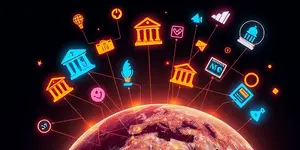
As digital and physical realities converge, the metaverse is emerging as a fertile ground for innovation and investment alike.
By 2025, the global metaverse market is projected to reach $507.8 billion in value, driven by rapid advancements in immersive technologies and widespread consumer interest. Census data indicates that long-term forecasts suggest this market could expand to $13 trillion by 2030, highlighting the explosive potential of the sector.
Consumer adoption is surging among younger demographics: an estimated 65% of Gen Z and Millennials in the US engage with metaverse platforms weekly, logging on for an average of 1 hour and 48 minutes per day. This growing engagement underpins the economy’s capacity to blend entertainment, social interaction, and commerce within virtual realms.
Regionally, North America currently holds the largest user base, but the Asia-Pacific region is outpacing all others with 41% year-on-year growth in active users, fueled by broad mobile penetration and cultural enthusiasm for digital experiences.
Investors can access the metaverse economy through a variety of channels, each offering distinct risk-reward profiles and strategic advantages.
Direct stock investments allow portfolio exposure to companies driving hardware and software development, while ETFs provide a balanced basket of assets mitigating single-stock volatility. Blockchain platforms unlock ownership of virtual land and in-game assets through NFTs, whereas venture capital offers high-risk, high-reward stakes in promising early-stage ventures. Indirect investments in cloud, semiconductor, or gaming companies add another layer of diversification for cautious investors.
The backbone of the metaverse hinges on massive computing and connectivity, ensuring smooth, real-time interactions for millions of users. High-performance semiconductors from NVIDIA and AMD, paired with robust cloud services from Amazon and Microsoft, form the critical underpinnings of immersive experiences.
3D creation software, such as Unity and Unreal Engine, empowers creators to build expansive worlds and realistic assets. Meanwhile, ultra-fast, low-latency networks are vital to prevent lag and preserve engagement as users explore virtual environments, attend events, or engage in commerce.
As the metaverse expands, cybersecurity measures must evolve to safeguard user data and digital assets. Protocols for identity verification, secure transactions, and fraud prevention are non-negotiable for maintaining trust and stability in virtual economies.
Despite its promise, the metaverse economy faces several hurdles that investors must consider carefully:
Mitigating these risks requires robust governance frameworks and continuous technological innovation, coupled with ongoing dialogue between industry stakeholders and regulators.
Looking ahead, the metaverse is poised to become a central pillar of the global digital landscape. Businesses across sectors are exploring immersive commerce opportunities, from virtual storefronts to experiential marketing campaigns. Education platforms anticipate delivering fully interactive virtual campuses, while corporate training programs will leverage realistic simulations for skill development.
New job categories are emerging, including virtual architects, metaverse event planners, and digital asset brokers. Financial institutions are preparing to offer specialized services for trading virtual currencies and managing digital assets, effectively creating a parallel financial ecosystem within virtual worlds.
The convergence of the metaverse with AI and the Internet of Things promises to enhance personalization and responsiveness. Virtual environments will adapt dynamically to user preferences, while real-world devices sync seamlessly with digital avatars, further blurring the lines between physical and virtual experiences.
Innovation and imagination converge in the metaverse, offering investors a chance to participate in one of the most transformative shifts in digital history. By recognizing diverse investment channels—from direct equities and ETFs to blockchain platforms and private equity—investors can craft strategies that align with their risk tolerance and horizons.
As challenges like regulation, security, and interoperability are addressed, the metaverse economy will continue its rapid ascent, unlocking unprecedented opportunities in commerce, education, entertainment, and beyond. For those willing to navigate this dynamic landscape, the rewards could be as boundless as the virtual worlds themselves.
Embrace the future, explore new dimensions, and position your portfolio at the forefront of the digital revolution.
References













